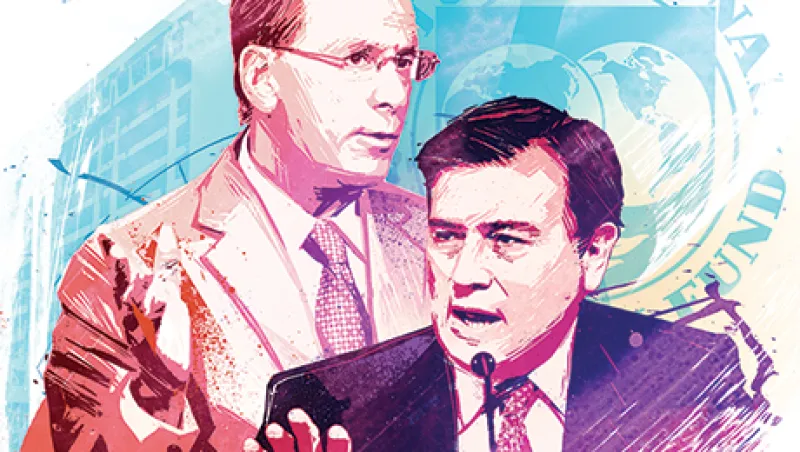Mid-October’s market gyrations, when volatility spiked in everything from U.S. Treasuries to European bonds, gave investors a taste of what wild fixed-income markets look like after three years of relative calm. Many blamed a lack of liquidity for the fluctuations. But there was probably more to the story as the yield on the U.S. Treasury’s benchmark ten-year notes went from 2.19 percent to 1.86 percent in seconds and five-year notes moved even more dramatically.
These events coincided with the International Monetary Fund’s latest Global Financial Stability Report. Titled Risk Taking, Liquidity, and Shadow Banking: Curbing Excess While Promoting Growth, the GFSR suggested the need for more regulation, or at least scrutiny, of asset managers to contain potential systemic risks.
At this month’s IMF and World Bank meetings in Washington, Larry Fink, chairman and CEO of U.S. asset management giant BlackRock, appeared on a panel chaired by José Viñals, director of the IMF’s monetary and capital markets department, which produced the GFSR. “Let me first thank you for not calling me a shadow bank,” Fink joked after Viñals introduced him. Fink’s take on the systemic risk posed by big firms like $4.5 trillion BlackRock: “This is not our money. I don’t have any leverage. We lend money that clients have entrusted to us.”
The recent volatility was partly a reaction to gloomy news from the IMF and weak industrial production numbers out of Europe’s largest economy, Germany. There was a flight to quality by portfolio managers dumping less liquid securities for the most easily traded: Treasuries.
But that news wasn’t enough to trigger the brief chaos. Traders and bond managers pointed to several other factors. First, implied volatility has been very low in both stocks and rates, as seen in the Chicago Board Options Exchange’s Volatility Index, the VIX, and the Merrill Option Volatility Expectations Index, or MOVE, which reflects a market estimate of future Treasury bond yield volatility. Multiple funds, including hedge funds, were short options so they could pick up some income in their portfolios. When the markets turned, they were forced to unwind their positions and trade the underlying securities.
“When we hit 1.86 percent on Treasuries, that was the result of the exiting of short volatility positioning,” says Jack Flaherty, a portfolio manager of the Unconstrained Bond Strategy at GAM, a $120 billion, London-headquartered asset manager. “That’s where the huge move in Treasuries came from,” adds Flaherty, who is based in New York.
The GFSR sounds the alarm that most investors share the same view of fixed income: Interest rates will go up eventually. By racing to sell when they see others doing it, investors are exhibiting the same herd behavior as in other market cycles. Of course, the Federal Reserve and other central banks have indirectly encouraged herding with their loose monetary policies. After a while they’ll have no choice but to stop printing money.
Last year’s taper tantrum, when rates rose after the Fed hinted it would rein in its bond buying program, set off a rush of mutual fund redemptions. But markets quickly calmed, giving investors false confidence that they could anticipate market changes. GAM’s Flaherty notes that the market’s mechanisms work even when people herd: “There’s a price for everything. It just might not be what you want.”
Regulators are right to worry about funds that promise daily liquidity in securities like bank loans that don’t trade so readily. Funds guarantee that investors can withdraw their money each day, but the firms still need to go into the markets to buy and sell. This situation encourages retail investors to purchase instruments that might not be a good fit with their time horizon.
One of the biggest causes of this month’s volatility is a broken system for trading corporate credit, which relies on banks putting up capital. Before the crisis money managers could sell huge positions in bonds anytime. Banks were flush with borrowed money. When that ended in 2008, regulators changed the rules and banks retreated from this profitable role. There’s plenty of liquidity — debt issuance has surged in the past few years — but the system to get it from A to B isn’t working. Although money managers, issuers, electronic trading platforms, regulators and even dealers are tackling the problem, they’ve only begun to fix it.
Many traditional money managers are adding the most liquid securities to their bond portfolios as a hedge against the inevitable: more-volatile markets. Northern Trust, Prudential Investments and TCW Group are all positioning themselves for a liquidity crisis. If they don’t have to sell, they can be big buyers in a downturn.







